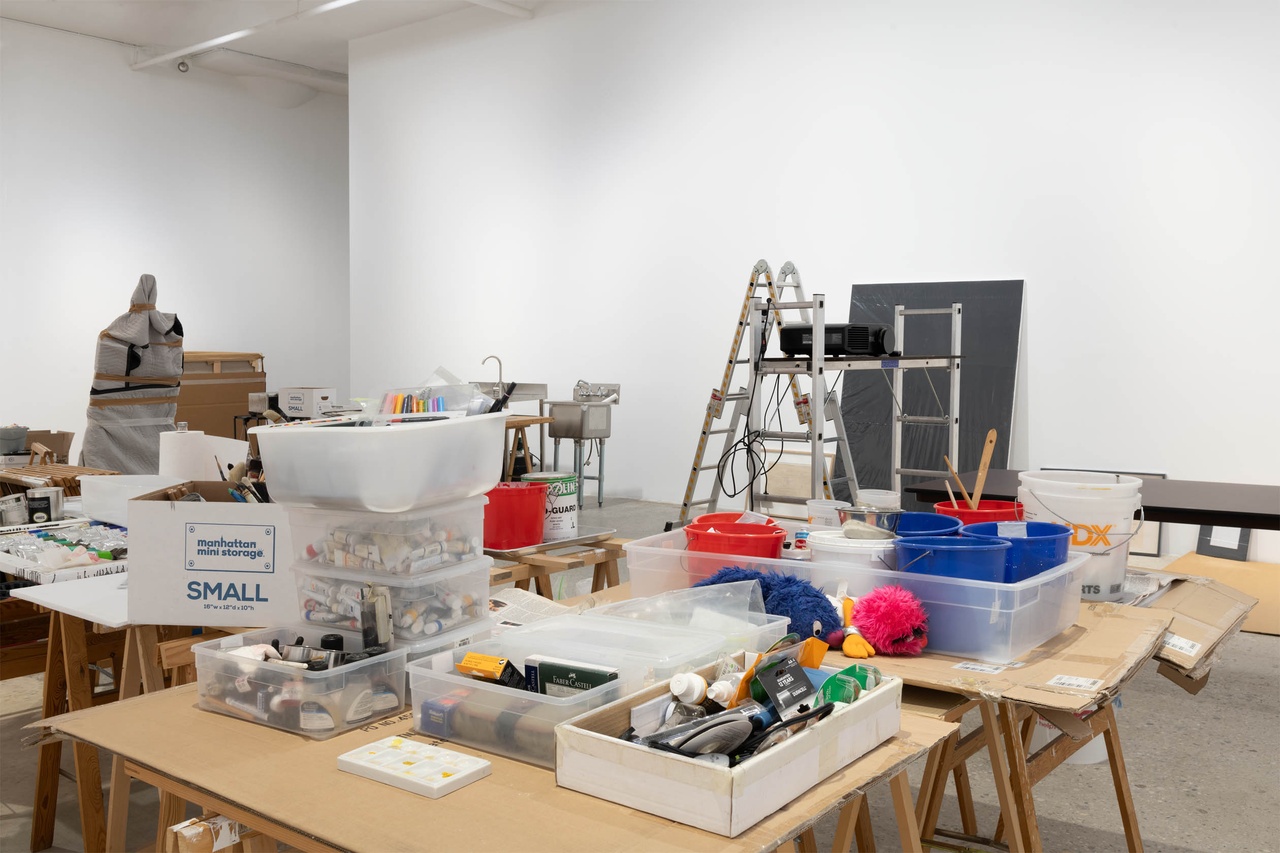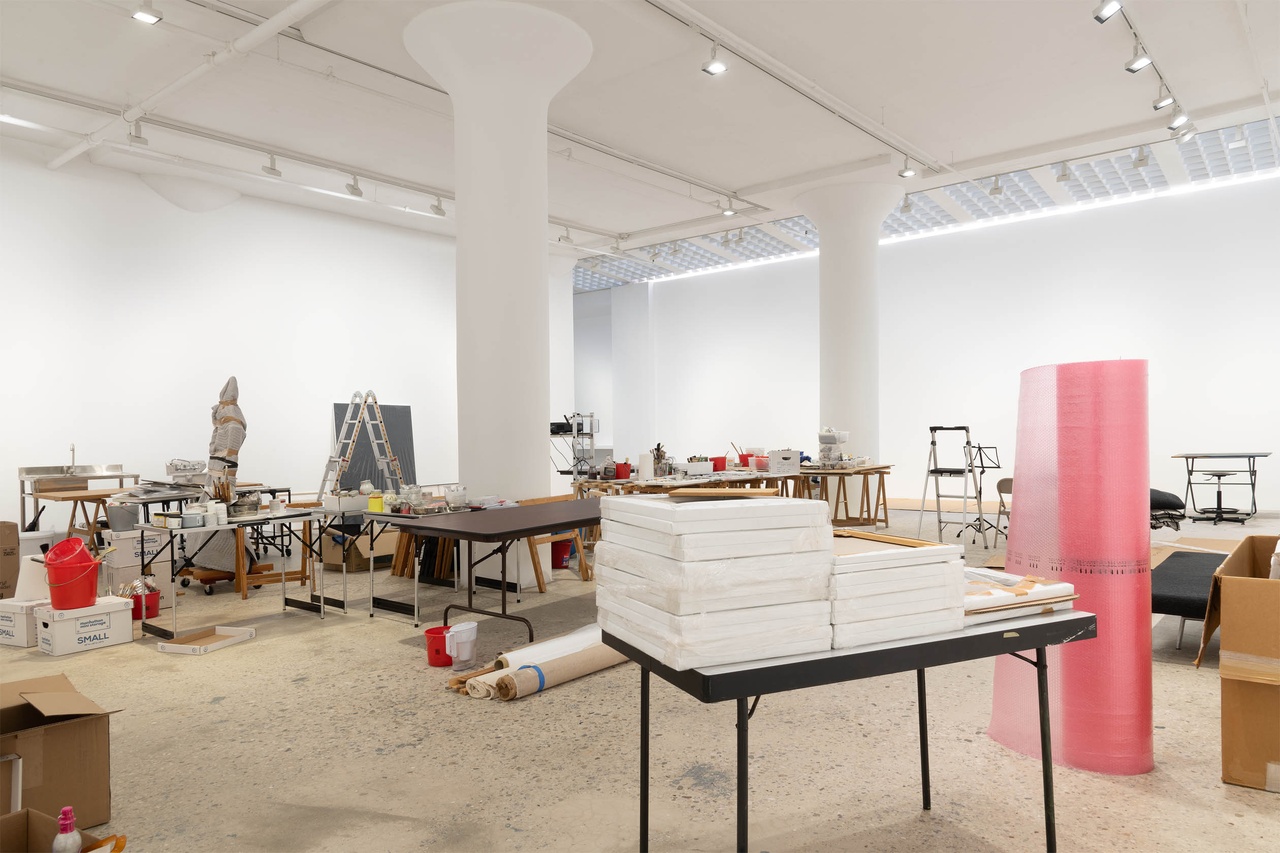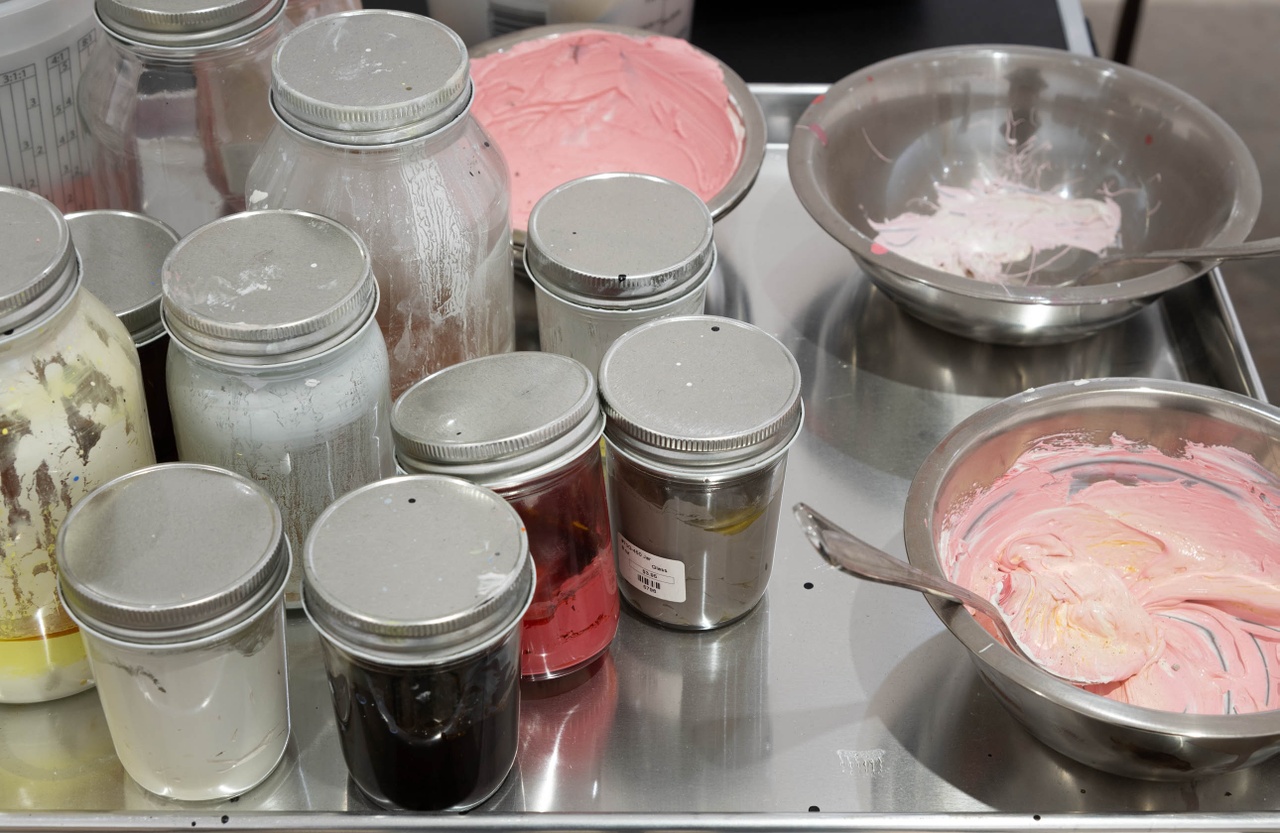MICHAEL KREBBER’S WAITING ROOM Harmon Siegel on Michael Krebber at Greene Naftali, New York

Michael Krebber in Greene Naftali, New York, 2024
To the romantically inclined, the miracle of art demands a suitably wondrous birthplace. Walled away from the profane world, the painter broods alone with his strange and cryptic objects. Rare gemstones and Ottoman scimitars glint in the last light of dying candles as sand trickles from the hourglass. Only there can the artist transfigure lumps of ochre pigment and pools of linseed oil into Venus or Madonna, there, in the studio.
At first, Michael Krebber’s latest exhibition seems calculated to debunk these literary tropes, insisting upon the prosaic realities of painting as a profession. The show consists of the contents of his studio, moved into the gallery space of Greene Naftali. Instead of a claustrophobic cell, we enter a grand, high-ceilinged showroom. Instead of exotic bibelots, we find household appliances. And instead of paintings we see paint. Lots and lots of paint. In short, Krebber stages a nearly systematic inversion of the romantic atelier – complete with a joking reference to its most emblematic inhabitant, Eugène Delacroix, whose name appears on the label for a store-bought fixative spray. In the end, however, Krebber’s restaging does not reject this image of the studio so much as press it into service, recruiting its tropes to enrich his broader project: “an exaggerated deferral of the act of painting, [making] delay itself into the content of his work.” [1]
As any procrastinator knows, not working can be hard work. For Krebber, the commitment to postponement has required inventive maneuvers. He has circled backward, as in 1990, when he re-stretched and exhibited a painting he first made in 1978. He has outsourced paint application, as in 2007, when he riffed on his teacher Martin Kippenberger’s tactic of hiring a sign painter, whom he tasked with transferring his lecture notes onto screen-printed supports. And he has repurposed painting-evoking materials, as in 2003, when he mounted readymade fabrics on stretchers without adding any marks. Of course, he does sometimes paint. But when he does, the results look decidedly tentative, more like abandoned sketches than finished tableaux. In his series Herbes de Provence (2018), brushstrokes float in white expanses. The pigment drags thinly, as though Krebber had trouble fully committing to his gestures. The imbalanced compositions do not hold together, as though the painted marks were struggling to escape their supports and restore the canvas to its pristine state.

Michael Krebber in Greene Naftali, New York, 2024
To explain his practice, Krebber has constructed a pantheon of declination and dithering. [2] There is the lord of refusal: Bartleby the scrivener, the low-level functionary in Herman Melville’s short story, who politely declined all orders with a shrugging, “I would prefer not to.” There is the patron of dallying: Monsieur Hulot, the good-natured protagonist of Jacques Tati’s films, whose progress through the world is repeatedly knocked off course by technological breakdowns and bureaucratic obstacles. And there is the daemon of futility: Marcel Broodthaers, who abandoned his hopes for a career in poetry by encasing his books in plaster, teaching Krebber that “you can have or make a picture, [but] you can also easily walk out of the room.” [3]
What room? The studio, of course! But can Krebber walk out of it? That depends on what it is, or, rather, what it does. Fundamentally, argued Daniel Buren, the studio functions as a frame, “the first limit, upon which all subsequent frames/limits will depend.” [4] This framing occurs at three levels. First, the studio precedes the works that are made within it. Second, it is stationary, remaining in place as the portable artworks inside are moved to other spaces. Third, it is private, with visitors needing permission to visit – a requirement enabling discrimination, the artist choosing who sees their works and which works they see.
Modernist art has proven most other frames/limits dispensable. When Georges Seurat extended his dots beyond the limits of his canvas and Constantin Brancusi sculpted his pedestals, they dissolved the difference between the means and ends of display. And, in 1964, Lucas Samaras did the same for his workspace, moving his combined bedroom/studio out of his parents’ home in New Jersey and reinstalling it at the Green Gallery. This gesture challenged all the framing functions that Buren enumerated. It neither precedes its exhibition nor remains stationary, since it is not an artwork until constituted as such in the gallery space. It is pointedly indiscriminate, open to anyone wishing to enter. And it requires no selections because it contains only one work, the studio itself.

Michael Krebber in Greene Naftali, New York, 2024
Samaras’s work had an inevitability to it – ejected from his familial home, he needed to move out. With Krebber’s installation, on the other hand, his usual workspace now stands empty. The operation thus inverts the neo-avant-garde tradition of exhibiting vacant galleries, typified by Yves Klein’s Le vide (The Void, 1958). Whereas Klein disclosed the space of the room as pure architectural container, Krebber denies the viewer even that minimal experience of formal unity. Instead, we enter into chaos, filled with objectified nothing. Containers contain nothing and supports support nothing. A shredder shreds nothing and a printer prints nothing. A table has nothing on top and boxes have nothing inside. The closest that anything comes to something: trays and jars and cans of paint – with which Krebber painted nothing.
This proliferating nothingness brings us back to the literary studio via one of its core tropes: the devastating secret occulted within. Sometimes, we learn that the painter never started painting. Exhibit A: Henry James’s “The Madonna of the Future,” in which an eccentric artist, Theobald, has been rumored for years to be toiling on his masterpiece. Only when the narrator enters the painter’s studio does he see that the canvas remains blank, Theobald moaning as he dies, “I am a dawdler […] that can’t act, that can’t do nor dare!” [5] Sometimes, we learn that the painter could never finish painting. Exhibit B: Honoré de Balzac’s “The Unknown Masterpiece,” in which a master painter, Frenhofer, carefully guards his magnum opus, allowing no one to see it in progress. But when a young apprentice finally gains access to his elder’s atelier and the covert work is revealed, he discovers nothing but a sliver of a foot beneath a grotesque impasto mass. [6]
Is Krebber Theobald or Frenhofer, never starting or never finishing? The reconstructed studio brims with papers and canvas. But, unlike in Samaras’s case, these all remain blank; it includes no works in progress. While the tubes of paint are capped, they crinkle and flatten toward their ends, suggesting that, at some point, the artist has squeezed out pigment. More flamboyantly, cotton-candy-colored paint encrusts a pair of mixing bowls and spoons, invoking the painter’s absent hand. Someone has started something – but what remains unclear. Krebber thus disperses painterly ambition from one masterpiece (à la James’s and Balzac’s heroes) to the totality of his studio practice, suspending the narrative structure of beginning, middle, and end. Certainly, any given artwork can be finished, framed, and exhibited. But what of the entire tradition? Does painting itself have a definable terminus – and how could we know if it did? Call it a halting problem.

Michael Krebber in Greene Naftali, New York, 2024
That phrase invokes a mystery in the theory of computation, one prompted by the Turing machine, two diagrams of which Krebber posted in the foyer of his exhibition. [7] The machine can, in principle, implement any algorithm. It consists of an infinitely long piece of blank tape, divided into cells like a film strip, each of which can contain a symbol. [8] It reads the symbols one by one, and, based on what each says, replaces the sign and shifts the strip left or right. In some algorithms, the process will come to an end. But, if it always finds new instructions to implement, it can also go on indefinitely. The halting problem then asks: Can we always determine in advance if an algorithm will come to a stop or go on forever? It turns out that the answer is no; there is no way to know in advance what constitutes a halting program versus an indefinite one.
In the press release, Krebber describes his studio as a painting machine. Will the machine ever stop? A given painting might be completable, or, like Frenhofer’s, it may not be. But there is no way to decide whether painting as an art can ever reach an end. To know if it will halt, we must go to the studio – and wait.
“Michael Krebber,” Greene Naftali, New York, September 13– October 26, 2024.
Harmon Siegel is a Junior Fellow at the Harvard Society of Fellows and author of Painting with Monet.
Image credit: Photos Júlia Standovár
Notes
| [1] | Michael Sanchez, Michael Krebber: Catalogue Raisonné, vol. 1 (Cologne: Galerie Buchholz; Walther König; New York: Greene Naftali Gallery, 2022), 13. |
| [2] | Karola Grässlin, Kunstverein Braunschweig, eds., * Michael Krebber: Apothekerman, exh. cat. (Cologne: Walther König; Wolfsburg: Städtische Galerie Wolfsburg; Braunschweig: Kunstverein Braunschweig, 2000). |
| [3] | Michael Krebber interviewed by Isabelle Graw, “Michael Krebber’s Perspective,” Kaleidoscope 17 (Winter 2012/13): 62. |
| [4] | Daniel Buren, “The Function of the Studio,” trans. Thomas Repensek, October 10 (Autumn 1979): 51–58. |
| [5] | Henry James, “The Madonna of the Future” in The Madonna of the Future: A Bundle of Letters: The Diary of a Man of Fifty: Eugene Pickering (London: Macmillan, 1883), 41–42. |
| [6] | In 2015, Krebber participated in a thematic show addressing Balzac’s tale’s “suspension of the figurative problem of the enveloping surface – the incarnate.” See the press release for “The Unknown Masterpiece," Galerie Meyer Kainer, Vienna (2015). |
| [7] | For the following summary, I am greatly indebted to physicist Jordan Cotler. |
| [8] | Notably, Krebber also included in the exhibition his edition of Marcel Broodthaers’s “A Second of Eternity,” which consists of a film strip, the frames of which contain his initials, designed to be projected in an endless loop. |
